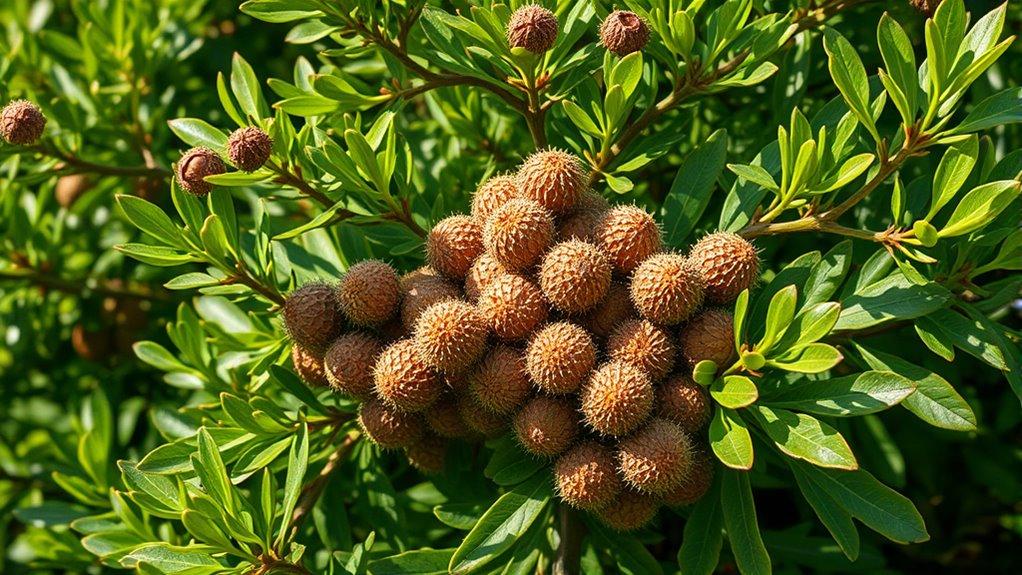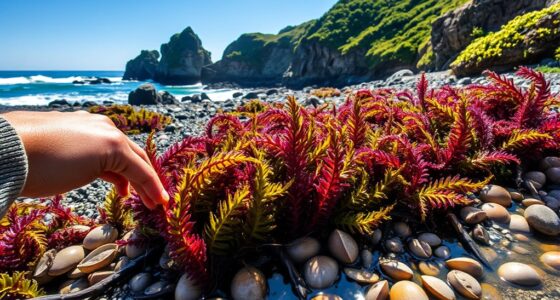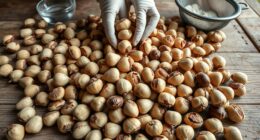To identify hazelnut or filbert shrubs, look for dense, bushy plants that stand 8 to 20 feet tall, with ovate, serrated leaves and clusters of nuts encased in tough shells. You’ll know nuts are ripe when the husks split open naturally, usually from late summer to early fall. Monitoring this sign helps you harvest at the right time, ensuring good quality. Keep exploring to learn more about managing and harvesting a healthy hazelnut orchard.
Key Takeaways
- Identify hazelnut shrubs by their 8-20 ft height, dense foliage, and ovate, serrated leaves that turn golden in fall.
- Nuts are ripe when husks split open naturally, usually in late summer to early fall.
- Monitor husk splitting to determine the optimal harvest window and avoid under- or over-ripening.
- Proper orchard management and pest control ensure high-quality nuts and timely harvests.
- Regularly inspect for pests like filbertworm, aphids, and spider mites to maintain healthy shrubs and good yields.

Hazelnuts, also known as filberts, are small, nutrient-rich nuts that pack a flavorful punch. If you’re seeking freedom from the constraints of supermarket options and want to take control of your nut supply, understanding how to identify hazelnut shrubs and determine the right harvest timing is vital. When you explore nut orchard management, you’re stepping into a world of self-sufficiency. Recognizing a hazelnut shrub isn’t just about spotting its size or shape; it’s about understanding its unique growth habits and how it fits into your landscape. These shrubs typically grow 8 to 20 feet tall, with dense, bushy foliage that’s vibrant in spring and summer. The leaves are ovate with serrated edges and turn golden in fall, signaling that your harvest window is approaching. The nuts themselves develop in clusters, encased in a tough shell, and are ready for harvest when the husks split open naturally, revealing the nut’s ripeness.
Achieving a successful harvest hinges on precise timing. You need to stay vigilant as the nuts mature, usually in late summer to early fall, depending on your climate. The key is to monitor the husks—they should split open naturally, indicating that the nuts are ready. Harvesting too early means underdeveloped nuts, while waiting too long risks losses from weather or pests. As part of nut orchard management, you also have to embrace pest control strategies that safeguard your crop. Pests like filbertworm, aphids, and spider mites threaten your harvest, so implementing integrated pest management is essential. Regularly inspecting your shrubs, employing natural predators, and, if necessary, applying organic controls can keep pests at bay without compromising your goal of liberation from chemical dependencies.
Your pest control strategies should focus on early detection and prevention. Keep your orchard clean, remove fallen husks and debris, and prune to improve air circulation, which discourages pest infestations. Use barriers or traps where appropriate, and consider biological controls like beneficial insects to maintain a balanced ecosystem. This proactive approach ensures you’re not just reacting to pests but preventing them from becoming a threat. When you combine attentive nut orchard management with effective pest control, you’re empowering yourself to harvest high-quality hazelnuts on your schedule. You’re no longer bound by the limitations of commercial growers—your nut orchard becomes a symbol of independence and self-reliance. With knowledge and vigilance, you can enjoy the satisfaction of harvesting your own nutrient-dense, flavorful hazelnuts, transforming your landscape into a source of nourishment and freedom.
Frequently Asked Questions
How Do I Distinguish Hazelnuts From Similar Nut Varieties?
To distinguish hazelnuts from similar nut varieties, focus on nut shell differences and leaf shape variations. Hazelnuts have smooth, round shells with a slightly pointed tip, while others may be more elongated or textured. Their leaves are typically oval with a serrated edge, unlike similar nuts that might have different leaf shapes. By recognizing these details, you can confidently identify hazelnuts and free yourself from confusion.
What Pests Commonly Affect Hazelnut Shrubs?
You’ll find aphids, hazelnut weevils, and scale insects commonly threaten your hazelnut shrubs. To keep pests at bay, focus on pest prevention through regular monitoring and promoting healthy growth. Use organic controls like neem oil or insecticidal soaps to combat infestations without chemicals. This approach empowers you to protect your harvest naturally, ensuring your hazelnuts stay healthy and vibrant, freeing you from reliance on harsh pesticides.
Can Hazelnuts Grow in Containers or Small Spaces?
You can definitely grow hazelnuts in containers or small spaces—it’s like freeing your gardening dreams from the ground! With clever space-saving techniques and container gardening, you’ll enjoy fresh nuts without needing a sprawling garden. Use large pots, provide ample sunlight, and guarantee proper watering. This way, you take control of your harvest, transforming tiny spaces into lush hazelnut havens where you’re the boss of your bounty.
Are There Any Specific Soil Amendments for Hazelnut Cultivation?
You should consider soil pH modification to keep your hazelnuts thriving; they prefer slightly acidic to neutral soil. Incorporate organic composting to enrich the soil and improve drainage. These amendments boost nutrient availability and promote healthy growth. By adjusting soil pH and adding rich organic matter, you take control of your hazelnut cultivation, empowering you to create the perfect environment for a bountiful harvest.
How Do I Store Harvested Hazelnuts for Long-Term Use?
Think of your hazelnuts as treasures waiting to be opened. To store them long-term, wait until harvest timing is perfect—nuts are fully mature and dry. Clean and dry them thoroughly, then keep them in airtight containers in a cool, dark place. For maximum liberation, consider refrigeration or freezing to preserve freshness and prevent spoilage. Proper storage lets your hazelnuts stay delicious and ready to enjoy whenever you desire.
Conclusion
As you tend to hazelnuts and filberts, remember they’re like a delicate dance—each step in shrub identification and harvest timing shapes the symphony of a successful harvest. Your patience and keen eye are the keys to revealing their hidden treasure. When you finally gather these nuts at just the right moment, it’s like catching a fleeting whisper from nature itself. Embrace the journey, and your efforts will bloom into a harvest that’s truly worth the wait.










